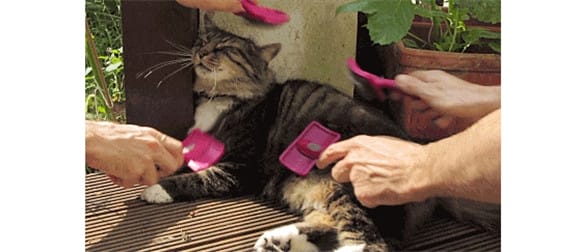For most people, spring is a breeze and flowers blooming, but for a few people, it is a torture - repeated sneezing, runny noses and tears.
Human allergy to plant pollen is called "hay fever". Can cats also get hay fever?

Anaphylaxis:
Allergy is an abnormal immune response to a harmless stimulus.
Cats are generally not congenital allergies, but develop with age. It is usually discovered between the ages of 6 months and 3 years old. Due to the difficulty of diagnosis, some cats are not diagnosed until they are 14 years old.
The common ones can be divided into the following types:
-Food allergy
-Atopic dermatitis
-Flea allergy Dermatitis
-Allergic contact dermatitis
Pollen allergy is atopic dermatitis
△A cat flower
Special Atopic dermatitis usually refers to an allergic reaction to environmental allergens such as pollen, mold, and house dust mites.
Among them, some allergies are seasonal, such as allergies to cedar, cypress, and ragweed pollen; others are non-seasonal, such as mold and dust mites.
The main symptoms are on the skin:
Allergic cats usually develop crusted papular dermatitis, also known as miliary dermatitis. You can feel many small and hard bumps on the skin when you touch it. Crusted lesions.
Other symptoms include: itching, otitis externa, skin ulcers, pustules, matted coat, and hair loss.
Atopic dermatitis may also cause sneezing, coughing, asthma-like respiratory problems, and conjunctivitis.
How to diagnose and treat?
Diagnosis is mainly through serological allergy test and intradermal test.
Allergies are caused by an overreaction of the immune system to substances that are not inherently dangerous. Therefore, we need to calm down excessive immunity:

1. Corticosteroids and antihistamines
In most cases, steroids will significantly reduce allergic reactions and quickly improve the clinical symptoms of cats. They can be taken orally or injected. It depends on the condition of the cat.
Although cats experience fewer side effects from long-term steroid use than dogs and humans, regular monitoring is still recommended.
Antihistamines may take 7-10 days to take effect, and some cats do not respond well to antihistamines.
In addition, supplementing essential fatty acids can strengthen the skin barrier and reduce the inflammatory response. It is also a slow-acting method and may also help reduce the chance of recurrence.
2. Immunosuppressive drugs
For example, cyclosporine, these drugs specifically target the immune cells involved in atopic dermatitis to reduce the immune response, usually starting within a month effect.
3. Desensitization therapy
Use specific antigens or allergy vaccines for desensitization, and use long-term low-dose stimulation to gradually reduce the body's response to such allergens.
Atopic dermatitis is a lifelong disease and frequent relapses are common.
For most cats, the goal is to reduce the severity of itching and improve quality of life, rather than eliminate it entirely.
In daily life, the following methods can help reduce environmental allergens:
1. Do not let cats go out, especially in spring and autumn
2. Immediately enter the house Take off your coat and bag and hang them in the hallway, or roll them from head to toe with a hair stick
3. Use an air purifier, preferably placed at the entrance or in a corner
4. Groom your cat every day

 扫一扫微信交流
扫一扫微信交流
发布评论